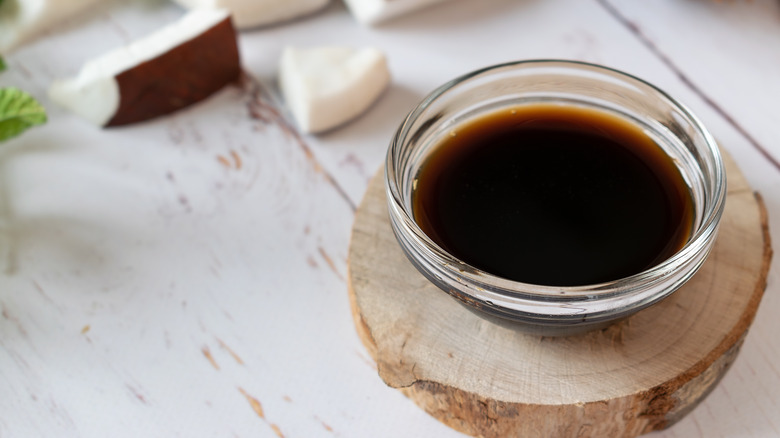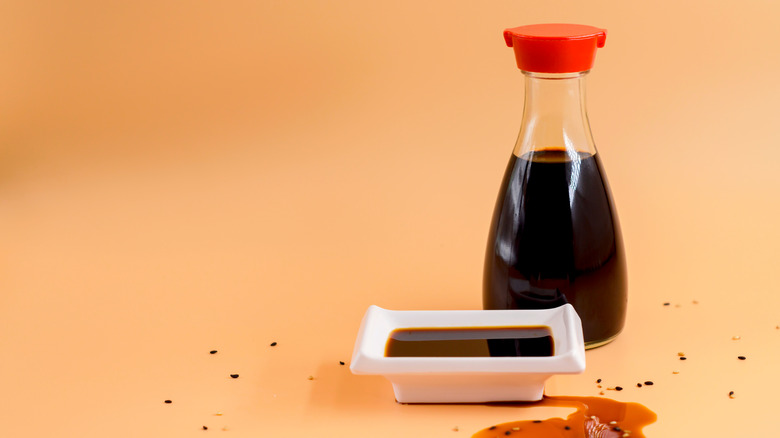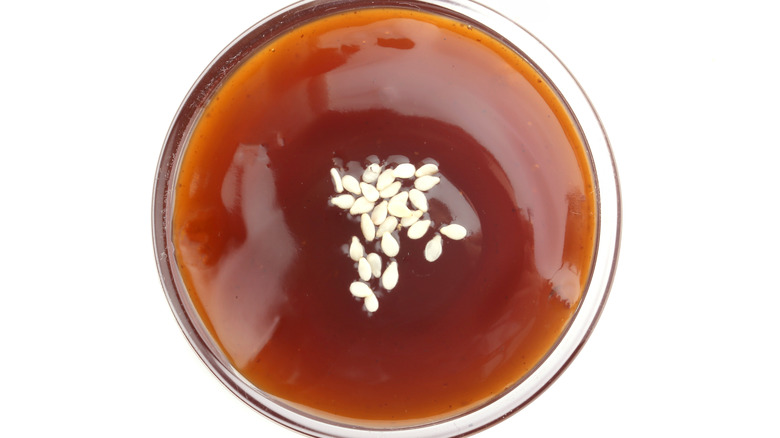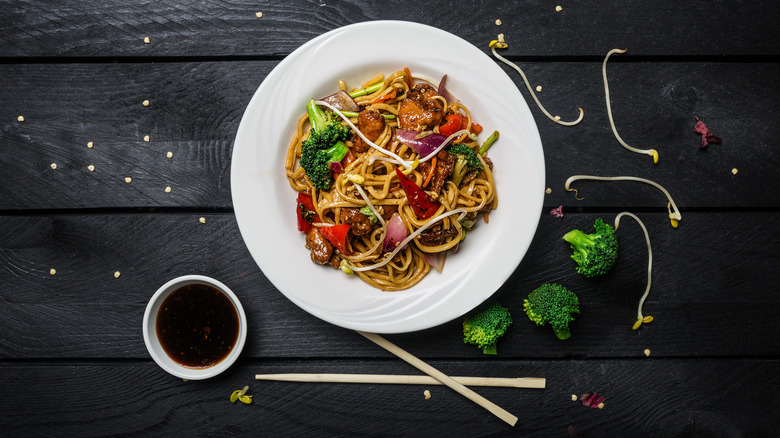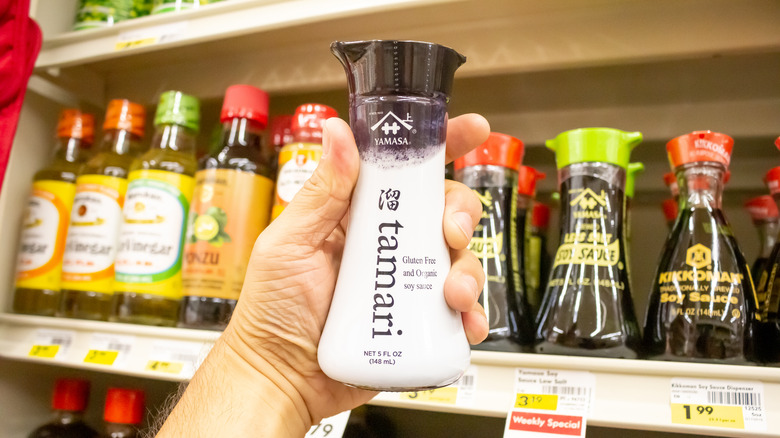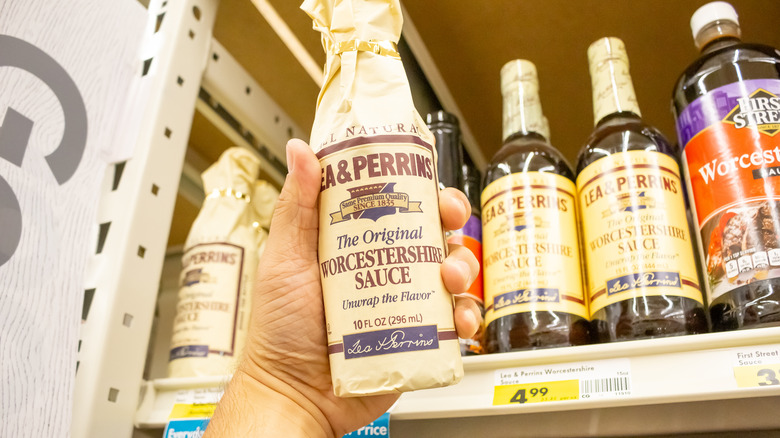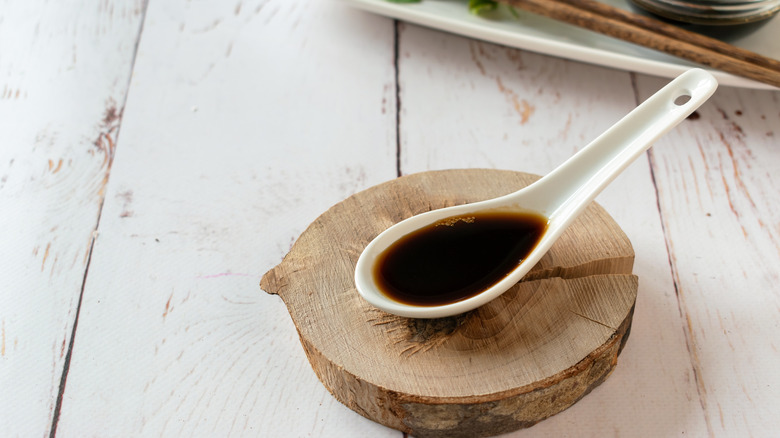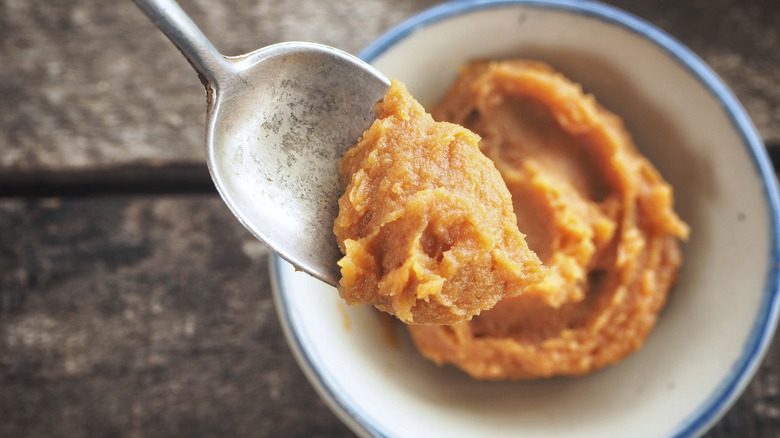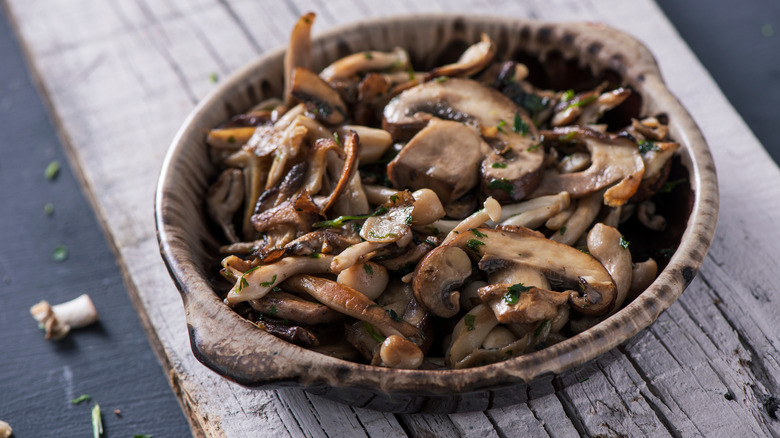10 Best Substitutes For Coconut Aminos
In addition to being appropriate for gluten-free diets, coconut aminos is gaining more recognition for its incredible ability to be a lower sodium dupe for soy sauce.
Coconut aminos is only made from two ingredients: coconut tree sap and sea salt. It also contains natural sugars, so when it gets fermented, its taste becomes very similar to, but slightly sweeter than, soy sauce. It gained wider popularity a few years ago amongst those with gluten-sensitive, paleo, and Whole30 diets. Because of this, it is dubbed as the ultimate alternative for soy sauce that can be paired with many dishes, ranging from scallion pancakes, dumplings, to sushi and sashimi.
However, coconut aminos has just recently become popular, only expanding in retailers aside from niche grocery stores and online markets in the last few years. Have no worries, because there are still many tasty alternatives to this newly desired sauce — many of which you can find in your pantry.
1. Soy sauce
The original sauce that coconut aminos became a popular substitution for, soy sauce is more widely available and affordable in most places. However, its salty flavor is more pronounced than coconut aminos' sweet flavor, which is something to keep in mind when making the swap. In addition, according to Thrive Market, it does contain about 65% more sodium than coconut aminos per serving, which some people might be wary of. The advantages of using soy sauce as a substitute for coconut aminos is that because the latter was originally used as a swap for the former, they can be interchanged in 1:1 ratios.
Soy sauce is a popular condiment both within and paired in many dishes, including egg rolls, wontons, and salad dressings. You can easily swap the same amount of soy sauce for coconut aminos that your recipe calls for.
2. Teriyaki sauce
Teriyaki sauce is also a popular umami sauce used to complement many Asian dishes including meats, vegetables, rice, and noodles. It is made out of soy sauce, sake, sugar, and ginger, according to Food Republic. However, because of its thicker consistency and sweeter taste, you might need to water it down. In addition, because of its richer texture, it is used more often as a marinade in dishes such as fried rice, rather than a dip like coconut aminos and soy sauce, which is also something to be mindful of.
Teriyaki can easily sub in for the soy sauce or coconut aminos. Just make sure to maybe water it down a small bit or combine it with some vinegar so that it is the same consistency as the original.
3. Soyaki sauce
Can't decide between the iconic, saltier taste of soy sauce and the sweeter, smokier flavor of teriyaki sauce? Why not try combining them both? The Trader Joe's marinade is vegan and comes in two varieties: the default and an island variety. This specialty sauce has a cult following, with many fans using it in stir fry, to season vegetables, and in rice and noodle dishes. Soyaki sauce is the perfect combination of both sauces because it has soy sauce's thinner consistency and teriyaki's sweeter taste, allowing you to use one bottle in recipes instead of one. It's also convenient in that it is a pretty popular Trader Joe's item, so if you have a location near you, you easily find it nestled among the other condiments. However, if you don't, you may want to look to use another alternative on this list, as it is a niche Trader Joe's item with pretty high reviews — with Refinery29 putting it on its list of Trader Joe's items to always keep stocked.
In this Culinary Mama's vegetable stir-fry recipe, soyaki sauce is used, but could easily be switched out with an equal amount of coconut aminos.
4. Tamari
Tamari is another popular substitution for coconut aminos. Tamari is technically a type of soy sauce, but it lacks wheat due to being a byproduct of miso paste, according to Healthline. This makes it acceptable to be implemented into gluten-free diets for the most part, although it is advisable to double-check the ingredients on a tamari bottle if you have an allergy to look out for. In terms of taste, tamari is slightly less salty than ordinary soy sauce but has a stronger umami taste because of its higher soybean content and lack of wheat.
Tamari is a popular substitute for soy sauce, and therefore can be used again to replace coconut aminos in the same quantities, according to A Couple Cooks.
5. Worcestershire sauce
Despite not having the same origins of tamari and soy sauce, Worcestershire sauce also makes for a pretty good replacement for coconut aminos. The vinegar-based sauce originated in Worcester, England, by two chemists in 1837, according to BBC. Since then, it's been enjoyed as a marinade, condiment, and in soups. Because of its long-standing popularity, Worcestershire sauce has the advantage of being widely available in supermarkets, which coconut aminos is still working towards. Nonetheless, the combination of its vinegar base with other ingredients such as anchovies, molasses, and sugar, gives it a comparable flavor to coconut aminos.
Worcestershire sauce can be swapped out with coconut aminos in 1:1 ratios. Steak marinades are a common usage of the sauce.
6. Liquid aminos
Liquid aminos is another great alternative for coconut aminos. Not to be confused with coconut aminos, liquid aminos contains soy, according to Healthline. This makes it unsuitable for those with soy allergies, yet it is still lower in sodium than many soy sauce varieties, according to The Healthy Home Economist. Because of this, using liquid aminos as a coconut aminos replacement can be more attractive to those who are trying to control their salt intake.
Because of its many similarities to soy sauce, according to the Academic Association of Medicine, liquid aminos can also replace coconut aminos in the same quantities. However, it is still saltier than coconut aminos, with 320 mg of sodium per teaspoon compared to the 90 mg of sodium in the same amount, which some people might still be cautious around. Liquid aminos can be used to saute vegetables, in rice and noodles, and of course, in stir-fry dishes.
7. Miso paste
Unsurprisingly, miso paste is on this list. Being the result of fermented soybeans, just like soy sauce, miso naturally takes on a similar flavor as coconut aminos' most well-renowned replacement, and it is relatively easy to find in the refrigerated section of grocery stores. Combined with water, it makes for a pretty strong substitute for coconut aminos in terms of taste, bringing in the same umami flavor. However, one downside is that the consistency is not quite the same, being a little more diluted from the water.
Therefore, it is advisable that this substitution is used in liquid dishes that the miso paste can also combine well into, according to PureWow. Use one part miso paste combined with one part water for every one part of coconut aminos a recipe calls for.
8. Dried shiitake mushrooms
This might come as a surprise to many, but when rehydrated in boiling water and left to soak, dried shiitake mushrooms have been used as a substitute for soy sauce — coconut aminos' most well known replacement. The water that the mushrooms are soaked in packs a surprisingly similar flavor to soy sauce and coconut aminos, and can be used in 1:1 with either sauce, according to The Kitchen Community. Of course, being only two ingredients and not being soy or fish-based like many other replacements, the flavor is not quite the same. Still, it comes close enough if you don't have any of the other substitutes on hand.
Like with the miso paste mixture, this mushroom liquid could work well in dishes such as broths and stews where it can mix well. Boil dried shiitake mushrooms in water and let them soak for a few hours. Use this soaking liquid as a direct replacement for coconut aminos.
9. Fish sauce
Fish sauce is typically made from fermented fish, according to Healthline. However, a major drawback of using fish sauce is that it is not vegetarian. With many of the other sauces on this list being vegetarian-friendly, it might not be your go-to alternative if you have dietary restrictions. It is still a popular option as a complement to sushi, dumplings, and spring rolls with its fishy, salty, umami flavor.
Fish sauce is used as a dip in many Asian dishes, and is also an ingredient in recipes for other condiments. One example is this Nuoc Cham (classic Vietnamese dipping sauce) by Drive Me Hungry. This recipe calls for 1/4 cup of fish sauce, but as noted later in the recipe, this can be made vegetarian with a soy sauce or coconut aminos swap, so you can still enjoy this tasty dip if you have a plant-based diet.
Fish sauce can be swapped out for coconut aminos in a 1:1 ratio.
10. A homemade variety
As illustrated throughout this article, coconut aminos has many similar flavors as a lot of the other sauces on this list, despite being of different origins and ingredients. That being said, it is easy to make your own substitute, with ingredients you probably already have. A benefit to making your own substitute coconut aminos sauce is that you can easily make it in large quantities to store and use later. Furthermore, if you have any allergies or dietary restrictions, you can customize your own homemade sauce to meet your needs.
Lots of coconut aminos alternatives on the web use another sauce on this list, but in smaller quantities. An example of this is this recipe by Real Simple Good, which uses fish sauce, along with beef broth, balsamic vinegar, tomato paste, onion powder, maple syrup, and sea salt to make a rendition of coconut aminos that tastes pretty dang similar to the real thing, while also saving you some money.
